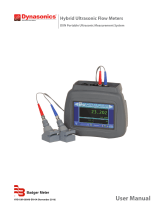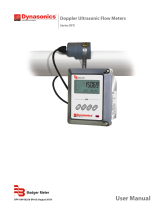Page is loading ...

1

2

3
TABLE OF CONTENTS
Service Information ............................................ 2
Quick Start Instructions .................................. 4-5
Introduction ......................................................... 6
Specifications ...................................................... 6
Controls and Terminology ................................. 7
Transducer Mounting Locations ....................... 8
Mounting the Transducer ................................... 9
Operating the FD613 ......................................... 10
Velocity to Volume Conversions ..................... 11
Battery Replacement ........................................ 11
Troubleshooting Guide .................................... 12
Velocity Conversion Chart ............................... 13
Spare Parts and Accessories .......................... 14
Warranty ............................................................ 15

4
QUICK-START INSTRUCTIONS
This manual contains detailed operating instructions for the FD613 instrument.
The following condensed instructions are provided to assist an experienced
operator in basic operation of the instrument. If the operator is unfamiliar with
this type of instrument, refer to the detailed explanations located at the
corresponding letter on pages 8-11.
A. Select a transducer mounting location at least 10 pipe
diameters downstream and 5 diameters upstream of
flow disturbances (i.e. elbows, tees, valves, etc.)
B. On horizontal pipe, choose a
transducer mounting location
approximately 90 degrees
from the top of the pipe.
C. Remove rust, scale and paint
from the transducer mounting
location. Clean to bare metal.
Plastic pipes do not require
preparation.
D. Plug the transducer plug into
the transducer jack.
STEP A
STEP B
STEP D

5
E. Apply approximately
⅛" (3mm) silicone grease
to the transducer face.
Place the transducer face
on the prepared area of
pipe. Hold the transducer
parallel to the pipe with
the cable pointing
downstream of the flow
direction.
F. Press the ON/OFF key.
Wait at least 30 seconds
before recording a
reading. The FD613 will
automatically turn itself
off after 3 minutes.
G. Change units of measure
by pressing the FT/SEC -
M/SEC key.
STEP E
STEP F

6
INTRODUCTION AND OPERATING THEORY
Series FD613 Phase Shift Flow Meters feature advanced Trans-Phase
measuring technology, providing accurate and reliable flow velocity
assessments in closed piping systems. The FD613 utilizes a non-
invasive transducer which is hand-held or strapped to the outside of a
pipe. Within seconds, the large 0.7 inch [18mm] LCD provides stable
readings in either FPS (Feet per Second) or MPS (Meters per Second).
This product is designed to operate on metal, plastic or rubber pipes
containing liquids with greater than 100 ppm of suspended solids or
entrained gases that act as reflectors.
Phase Shift flow meters utilize two piezoelectric crystals contained
within one transducer to transmit ultrasonic sound energy into the fluid
stream and receive reflected
sound from reflectors (suspended
solids or entrained gases) within
the liquid. See Figure 1. In
accordance with the theories of
Christian Johann Doppler (circa
1842), if the liquid is moving
(and
therefore carrying the reflectors
with it) and oscillating energy is
imposed on the moving reflector,
the reflected energy’s frequency of oscillation will be altered with
respect to the transmitted frequency. The magnitude of frequency
change is directly proportional to the velocity of the reflector.
SPECIFICATIONS
Description Specification
Power
Four AA alkaline cells provide over 30 hours
of operation
Flow Range
0.30 to 30.00 FPS [0.10 to 9.00 MPS]
Temperature
Electronics: -28°F to +140°F [-20°C to +60°C]
Transducer: -40°F to +180°F [-40°C to +82°C]
Enclosure Rating
NEMA 12X, splash resistant
Accuracy
±2% full scale
Transducer Mount
Hand-held (clamp on), utilize acoustic
couplant such as DOW 111
Figure 1

7
CONTROLS AND TERMINOLOGY
Note: The FD613 battery compartment
is located on the back of the enclosure.
Remove the two upper screws to gain
access to the battery compartment.

8
A. TRANSDUCER LOCATION
Selecting the proper location for taking a flow measurement is the single
most critical step in the operational procedure. The transducer utilized
by the FD613 flow meter contains two piezoelectric crystals for transmitting
and receiving ultrasonic signals through the wall of a pipe. Select a
transducer location with adequate straight runs (without flow disturbances)
of pipe, both upstream and downstream, to achieve stable and accurate
readings. Examples of common piping configurations and the
recommended minimum upstream and downstream pipe lengths are
included in Table 1.
Note: If adequate straight plumbing cannot be provided the FD613 will
operate repeatably
, but will most likely not achieve ideal accuracy.
FLO W
FLO W
FLO W
FLO W
FLO W
FLO W
Table 1

9
B. MOUNTING LOCATIONS ON THE PIPE
If the transducer is applied to
horizontal pipe, choose a
mounting position at
approximately 3 o’clock or 9
o’clock, assuming 12 o’clock to
be to top of the pipe. These
positions typically provide
optimum acoustic penetration
into the moving liquid. As
illustrated in Figure 2,
placement at the top or bottom
of the pipe can result in poor
sound penetration due to air
pockets (on the top of the pipe)
or sediment (at the bottom of
the pipe).
If the transducer is applied to vertical pipe, orientation does not matter.
C. PIPE PREPARATION
Before the transducer face can be coupled to a pipe surface, an area
slightly larger than the flat surface of the transducer must be cleaned to
bare metal on the pipe. Remove all scale, rust and paint. Thoroughly
dry and clean the mounting surface.
Note: For plastic pipes, such as PVC or PVDF, pipe preparation is
typically not required.
D. CONNECTING THE TRANSDUCER
Connect the transducer plug into the transducer jack. The connection
is polarized, so alignment of the keyway is necessary.
NOTE: The splash-resistant environmental seal is provided only when
the transducer plug is secured into the transducer jack. It is advisable
to make this connection before entering an area where the FD613 may
be dropped into or splashed with liquid.
E. APPLYING THE TRANSDUCER
To ensure an acoustically conductive path between the transducer face
and the prepared pipe surface, a coupling compound is employed.
Enclosed with the FD613 flow meter is a tube of Dow Corning 111
silicone based grease. This grease is adequate for the majority of
installations. If an alternate grease is utilized, the grease must be
specified not to flow at the temperature of the pipe surface or the
ambient conditions.
Figure 2

10
Figure 3
Apply an even layer of grease,
approximately ⅛" (3 mm) thick to the
flat surface of the transducer. Place
the transducer on the prepared area
of the pipe, with the cable pointing
downstream. See Figure 3. Align the
transducer with the pipe, ensuring
that it is parallel with the pipe wall.
Apply only enough pressure to hold
the transducer in place. If no reading
is shown, perform a “rub test” by
rubbing thumb across the dry
transducer head. The zeros should
display a low flow reading. See
Troubleshooting Guide for further
recommendations.
F. OBTAINING A READING
Press the ON/OFF key on the keypad. On power up, the FD613
performs internal diagnostics and starts the ultrasonic transmitter. The
display will read Hold for approximately 5 seconds during this time. If
the transducer is properly mounted to a pipe containing flowing liquid
with at least 100 ppm of 100 micron or larger particles or entrained
gases, the display will
begin to indicate velocity.
The default units of
measure are FPS (feet per
second). The response
time of the FD613 is
approximately 10 seconds
to obtain a reading.
Adequate signal strength
is obtained when the OK icon appears in the upper right corner of the
display. See Figure 4. Readings taken without this icon present may
be erroneous. It is recommended that survey readings of at least 30
seconds be taken to ensure reading stability.
The FD613 can be turned off by pressing the ON/OFF key on the
keypad, or the unit will automatically turn off after approximately 3
minutes of operation.
G. CHANGING UNITS OF MEASURE
Toggle between FPS (feet per second) and MPS (meters per second)
by depressing the FT/SEC - M/SEC key on the keypad.
Figure 4
Figure 3
Transducer Cable

11
H. CONVERSION FROM VELOCITY TO VOLUME
The velocity readings taken from the FD613 can be readily converted to
volumetric flow rate measurements such as GPM (gallons per minute)
or LPM (liters per minute). A chart is located on page 13 of this manual
that contains conversions for many popular schedule 40 pipe sizes. If
the pipe size is not located in this chart, use the following equations:
For conversion to GPM (pipe I.D. in inches):
GPM = FT/SEC 2.448 I.D.
2
For conversion to LPM (pipe I.D. in millimeters):
LPM = M/SEC 0.047 I.D.
2
I. LOW BATTERY INDICATION
When the power supply batteries become drained to a level of 4 volts,
the LOW BAT icon will illuminate on the right-hand side of the display.
Typical alkaline batteries will provide about 2 hours of operation after
the LOW BAT icon turns on. The flow meter will no longer operate
when battery voltage is less than 3.5 volts. At 3.5 volts and lower, an
Err1 will be displayed and then unit will shut off.
Replace the batteries by removing the two screws located on the upper
portion of the enclosure back. Install four fresh AA alkaline batteries
following the polarity indicated within the battery compartment and
replace the battery cover. A fresh set of alkaline batteries will provide
approximately 30 hours of service. Use of carbon-based batteries is
not recommended.
Do not allow discharged batteries to remain in the FD613 during
storage. Discharged batteries can leak and may cause severe damage
to the internal circuits of the FD613. Damage caused by leaking
batteries will not be covered under the manufacturer’s warranty.
J. DISPLAY TEST
The FD613 contains software to verify operation of the individual LCD
segments. To run the display test, turn the FD613 off. Press and hold
the FT/SEC - M/SEC key, then press the ON/OFF key. Release both
keys and verify that all segments illustrated in Figure 4 illuminate. The
FD613 firmware version number (FX.XX) is displayed at the end of the
test.
!

12
TROUBLESHOOTING GUIDE
Unit does not turn “ON”
when ON/OFF key is
pressed
Verify that batteries are installed and
contain a charge.
“Err1” is indicated
The batteries must be replaced.
No display readings are
obtained and no “OK”
icon is observed
Poor acoustic coupling to pipe. Apply
silicone grease to transducer.
Ensure pipe is full of a flowing liquid.
If the pipe has a plastic liner, move the
transducer to another location. The
liner may contain an air void.
Non-working transducer. Rub
transducer head with thumb for reading.
Liquid contains less than 3% total
suspended solids.
Move transducer closer to a source of
flow disturbance. (i.e. an elbow, pump
outlet or control valve.)
Dashes appear on display
Liquid velocity is greater than 30 FPS
(9 MPS).
Readings are obtained,
but the “OK” icon does
not turn on.
Signal strength is low. Flow readings
may be erroneous. Move the
transducer closer to a source of
hydraulic disturbance.
Erroneous Readings
Transducer mounted incorrectly.
Another local ultrasonic instrument is
operating at approximately the same
frequency as the FD613.
Excessive pipe vibration.
Very viscous (thick) liquids will cause
the unit to read lower than actual flow.
The pipe is not completely full of liquid.

13
LIQUID VELOCITY TO VOLUME CONVERSION CHART

14
SPARE PARTS AND ACCESSORIES
PART NUMBER DESCRIPTION
D002-2007-001 SS Mounting Strap, 36 inch (900 mm)
D002-2007-002 Nylon Mounting Strap, 30 inch (750 mm)
FDT-GREASE Couplant, Silicone (for temporary mounting)
FD613-S1 Series FD613 Small Pipe Transducer
FD613-S2 Series FD613 Standard Pipe Transducer
M-3238 Series FD613 Operations Manual
D003-1009-005 FD613 Carrying Case

15

16
/


